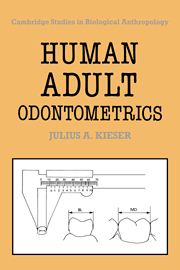Book contents
- Frontmatter
- Contents
- Foreword
- Preface
- 1 Introduction
- 2 Measurement of tooth size
- 3 Inheritance of tooth size
- 4 Comparative odontometry
- 5 Odontometric trends
- 6 Sexual dimorphism in tooth size
- 7 Odontometric variability
- 8 Compensatory tooth size interactions
- 9 Fluctuating odontometric asymmetry
- 10 Allometric relations of tooth size
- Odontometric appendix
- References
- Index
10 - Allometric relations of tooth size
Published online by Cambridge University Press: 05 February 2012
- Frontmatter
- Contents
- Foreword
- Preface
- 1 Introduction
- 2 Measurement of tooth size
- 3 Inheritance of tooth size
- 4 Comparative odontometry
- 5 Odontometric trends
- 6 Sexual dimorphism in tooth size
- 7 Odontometric variability
- 8 Compensatory tooth size interactions
- 9 Fluctuating odontometric asymmetry
- 10 Allometric relations of tooth size
- Odontometric appendix
- References
- Index
Summary
Introduction
Biological scaling is concerned with the effects and consequences of changes in size (Schmidt-Nielsen, 1975). The antiquity of interest in scaling is reflected in its derivation from the Latin word scala (staircase), which had by 1662 acquired the meaning of a systematic classification of objects proportionate to one another (Onions, 1973). Twenty-five years earlier, Galileo had published the Dialogues in which he discussed the proportional sizes of the bones of different sized animals. Realising that the mass of an animal would increase by the third power of its linear dimensions, Galileo noted that in order to support its body mass, a large animal would need bones that were not only absolutely, but also proportionately larger than those of smaller animals. Large and small animals are thus not geometrically similar; rather their proportions are scaled, such nongeometric scaling being referred to as allometric scaling (from the Greek, alloios which means different).
Investigations into the allometry of the human dentition probe the differences in the sizes of teeth or groups of teeth, and then associate these differences with the size or mass of other parts of the body. Allometric studies thus allow one to separate tooth size changes that occur in conjunction with changes in body size from those that occur independently of body size change. Thus, in its broadest sense, allometry allows one to determine whether teeth are larger ‘… all the better to eat you’, or whether they are larger merely as a consequence of the enlargement of another part of the body.
- Type
- Chapter
- Information
- Human Adult OdontometricsThe Study of Variation in Adult Tooth Size, pp. 112 - 126Publisher: Cambridge University PressPrint publication year: 1990
- 1
- Cited by



